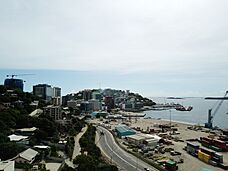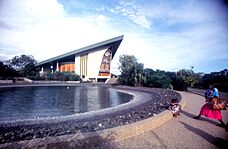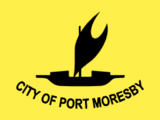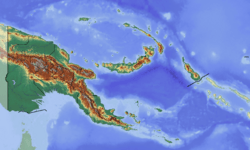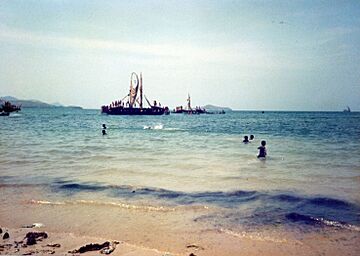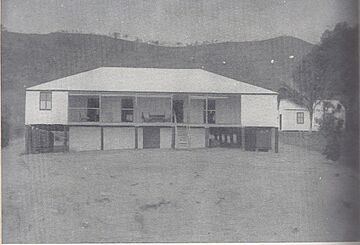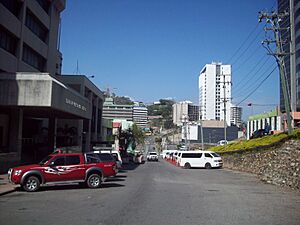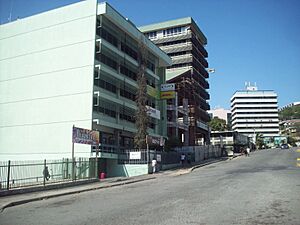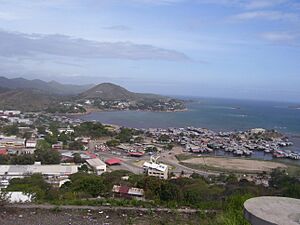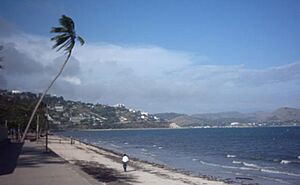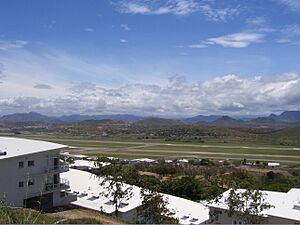Port Moresby facts for kids
Quick facts for kids
Port Moresby
Pot Mosbi (Tok Pisin)
|
||
|---|---|---|
|
Clockwise from top: Downtown of Port Moresby, Sir John Guise Stadium, National Parliament House, Jacksons International Airport
|
||
|
||
|
OpenStreetMap
|
||
| Country | ||
| Division | National Capital District | |
| Established | 1873 | |
| Named for | Admiral Fairfax Moresby | |
| Area | ||
| • Capital city | 240 km2 (90 sq mi) | |
| Elevation | 35 m (115 ft) | |
| Population
(2011 census)
|
||
| • Capital city | 364,145 | |
| • Density | 1,517/km2 (3,930/sq mi) | |
| • Urban | 700,000~ | |
| Languages | ||
| • Main languages | Motu, Tok Pisin, English | |
| Time zone | UTC+10 (AEST) | |
| Postal code |
111
|
|
| HDI (2021) | 0.729 high · 1st of 22 |
|
Port Moresby (pronounced "morz-bee"), also called Pom City or just Moresby, is the capital and largest city of Papua New Guinea. It is one of the biggest cities in the southwestern Pacific Ocean, not including Australia and New Zealand. The city sits on the coast of the Gulf of Papua, on the southwestern side of the Papuan Peninsula of the island of New Guinea.
Port Moresby started as a trading hub in the late 1800s. During World War II, it was a very important place for the Japanese forces to try and capture. They wanted to use it as a base to stop Australia from connecting with other parts of the world.
In 2011, Port Moresby had 364,145 people living there. By 2020, it was estimated to have about 383,000 residents. The area where the city is built has been home to the Motu-Koitabu people for hundreds of years. The first British person to see the area was Royal Navy Captain John Moresby in 1873. He named it after his father, Admiral Sir Fairfax Moresby.
Even though Port Moresby is surrounded by Central Province, it is not part of that province. Instead, it is its own special area called the National Capital District. The original landowners, the Motu and Koitabu people, have their own group called the Motu Koita Assembly that represents them.
In November 2018, Port Moresby hosted the APEC summit, a big meeting for leaders from different countries.
Contents
History of Port Moresby
Life Before Europeans Arrived
Before Europeans came, the area was home to the Motu-Koitabu people. The Motu usually lived by the coast, while the Koitabu lived more inland. These two groups often married each other. They lived in groups called iduhu, which were like family clans.
How the City Was Formed
In 1883, the Australian state of Queensland tried to take control of the southeastern part of New Guinea, which later became known as Papua. They were worried that Germany would take over the whole eastern half of the island. British leaders did not agree to this at first. However, after Germany took control of German New Guinea in 1884, Britain set up a protectorate over Papua. This meant Britain would protect the area, calling it British New Guinea.
In 1905, the Australian government passed a law called the Papua Act 1905. This law meant that Papua, with Port Moresby as its capital, would be directly ruled by Australia starting in 1906. From then until 1941, Port Moresby grew slowly. The port and other services on the peninsula got better. The first butcher shop and grocery store opened in 1909. Electricity came in 1925, and piped water arrived in 1941.
Port Moresby During World War II
During World War II, many Papuan men helped the Allied forces. Some joined the Papua Infantry Battalion. Others worked as porters, carrying supplies for soldiers through tough jungle paths. Many people living in Port Moresby went back to their home villages or to special camps when there was a risk of Japanese invasion.
By September 1942, Port Moresby became a very important base for the Allies. Thousands of troops were stationed there or passed through. It was the last Allied stronghold on the island. It also became a key starting point for the Allies to push back against the Japanese. General Douglas MacArthur had his main office in Port Moresby from November 1942 to October 1944.
In 1945, the Territory of Papua and New Guinea was created. This happened when Papua and the former German New Guinea (which Australia had managed since 1918) were joined under one Australian government. Port Moresby became the capital of this new combined territory. It became a central place for public services to grow. In 1972, Port Moresby officially became a city. Oala Oala-Rarua became its first Lord Mayor.
Becoming an Independent Nation
In September 1975, Papua New Guinea became an independent country, and Port Moresby was named its capital city. Prince Charles, Prince of Wales, represented the Queen of Papua New Guinea at the celebrations.
New government buildings, libraries, and cultural centers were built in a suburb called Waigani. These new buildings helped replace or add to the older ones in downtown Port Moresby. One important building was the National Parliament Building, opened in 1984 by Prince Charles. It mixes traditional designs with modern building styles.
The Papua New Guinea National Museum and the National Library are both in Waigani. Some older government buildings have been left empty due to not being taken care of. However, many old office buildings have been fixed up and used again since the early 2000s. The old courthouse in Port Moresby still stands today.
The number of people living in Port Moresby grew quickly after independence. In 1980, about 120,000 people lived there. By 1990, this number had increased to 195,000.
Climate and Weather
Port Moresby has a tropical savanna climate. This means it has warm temperatures all year round. It is the driest place in New Guinea, getting about 898.8 millimeters (35.4 inches) of rain each year.
The wet season runs from December to May, and the dry season lasts for the other six months. This is because of the southeast trade winds that blow along the coast. Also, high mountains surround the city, affecting its rainfall. Average high temperatures are between 28 and 32 degrees Celsius (82 to 90 degrees Fahrenheit). The average low temperature stays around 23 degrees Celsius (73 degrees Fahrenheit) all year. It is usually a little cooler in the city during the dry season.
| Climate data for Port Moresby, Papua New Guinea | |||||||||||||
|---|---|---|---|---|---|---|---|---|---|---|---|---|---|
| Month | Jan | Feb | Mar | Apr | May | Jun | Jul | Aug | Sep | Oct | Nov | Dec | Year |
| Record high °C (°F) | 36.2 (97.2) |
36.1 (97.0) |
35.4 (95.7) |
34.2 (93.6) |
33.8 (92.8) |
33.9 (93.0) |
33.3 (91.9) |
33.8 (92.8) |
34.8 (94.6) |
35.5 (95.9) |
36.3 (97.3) |
36.3 (97.3) |
36.3 (97.3) |
| Mean daily maximum °C (°F) | 32.1 (89.8) |
31.6 (88.9) |
31.4 (88.5) |
31.3 (88.3) |
31.0 (87.8) |
30.3 (86.5) |
29.9 (85.8) |
30.3 (86.5) |
31.0 (87.8) |
32.0 (89.6) |
32.5 (90.5) |
32.4 (90.3) |
31.3 (88.3) |
| Daily mean °C (°F) | 27.4 (81.3) |
27.3 (81.1) |
27.1 (80.8) |
27.0 (80.6) |
26.9 (80.4) |
26.1 (79.0) |
25.7 (78.3) |
26.1 (79.0) |
26.5 (79.7) |
27.5 (81.5) |
27.6 (81.7) |
27.8 (82.0) |
26.9 (80.4) |
| Mean daily minimum °C (°F) | 23.7 (74.7) |
23.5 (74.3) |
23.4 (74.1) |
23.5 (74.3) |
23.5 (74.3) |
23.1 (73.6) |
22.4 (72.3) |
22.6 (72.7) |
23.2 (73.8) |
23.5 (74.3) |
23.6 (74.5) |
23.7 (74.7) |
23.3 (73.9) |
| Record low °C (°F) | 20.4 (68.7) |
18.8 (65.8) |
18.3 (64.9) |
16.8 (62.2) |
14.5 (58.1) |
14.5 (58.1) |
10.4 (50.7) |
14.8 (58.6) |
14.4 (57.9) |
16.3 (61.3) |
16.0 (60.8) |
19.6 (67.3) |
10.4 (50.7) |
| Average rainfall mm (inches) | 192.2 (7.57) |
140.6 (5.54) |
189.8 (7.47) |
105.2 (4.14) |
56.2 (2.21) |
21.6 (0.85) |
13.8 (0.54) |
12.0 (0.47) |
14.4 (0.57) |
15.2 (0.60) |
40.0 (1.57) |
97.8 (3.85) |
898.8 (35.38) |
| Average rainy days (≥ 0.1 mm) | 18 | 16 | 18 | 11 | 9 | 6 | 4 | 4 | 5 | 5 | 6 | 12 | 114 |
| Average relative humidity (%) | 79 | 81 | 81 | 82 | 81 | 79 | 77 | 76 | 76 | 76 | 75 | 77 | 78 |
| Mean monthly sunshine hours | 182 | 158 | 184 | 200 | 211 | 200 | 203 | 222 | 213 | 231 | 243 | 216 | 2,463 |
| Source 1: World Meteorological Organization | |||||||||||||
| Source 2: Deutscher Wetterdienst (extremes, mean temperature, humidity and sun) | |||||||||||||
Areas and Neighborhoods
Port Moresby is the only district within the National Capital District. This district has three main Local Level Government (LLG) areas. For counting people (census), these LLG areas are divided into smaller sections called wards, and then into even smaller census units.
| District | District Capital | LLG |
|---|---|---|
| National Capital District | Port Moresby | Moresby North-East |
| Moresby North-West | ||
| Moresby South |
The government of the National Capital District also includes the Motu Koita Assembly. This group was created by law to represent the traditional landowners of Port Moresby, the Motu and Koitabu people. The Assembly manages the traditional lands and villages of these people. It is the only group of its kind in Papua New Guinea. The head of the Motu Koita Assembly is also the Deputy Governor of the National Capital District.
The name "Port Moresby" can mean the whole city area of the National Capital District. It can also refer specifically to the main business area, which locals call "Town."
Since the 1990s, the original town center has become a busy office area. The rich housing area north of downtown, along the coast, still has many large homes and apartment buildings.
The suburb of Boroko used to be the main shopping area, but now many old shopping buildings are empty. The western part of the city has many tall buildings, shopping centers, and nice houses. Other neighborhoods in Port Moresby include Koki (known for its fresh food market), Newtown, Konedobu, Kaevaga, Badili, Gabutu, Kila Kila, Matirogo, Three Mile, Kaugere, Sabama, Korobosea, Four Mile, Hohola, Hohola North, Boroko, Gordons, Gordons North, Erima, Saraga, Waigani, Morata and Gerehu.
Villages in Port Moresby
Some villages within Port Moresby are:
- Hanuabada
- Kira Kira village (also spelled Kirakira), which is the hometown of Australian soccer player Mary Fowler's mother.
Getting Around Port Moresby
Within Port Moresby, people get around using buses and private taxis. Flights are very important for travel across Papua New Guinea because the national highway system is not fully connected.
Port Moresby is served by Jacksons International Airport. This is the largest international airport in the country and also a base for the Papua New Guinea Defence Force Air Wing. Since there are not many direct roads, many flights go to other towns like Lae and Madang from Port Moresby.
Economy and Business
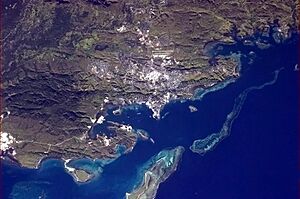
Papua New Guinea has many natural resources, which make up two-thirds of what the country sells to other nations. Because of these resources, foreign countries have helped develop some areas. For example, a US oil company started exporting oil in 2004. This was the biggest project in PNG's history and greatly increased the country's export earnings.
Papua New Guinea also gets a lot of help from Australia, receiving millions of dollars in aid each year. Countries like Singapore, Japan, and China also play a big part in PNG's industries. Hosting the 2018 APEC meeting brought many world leaders to Port Moresby.
There has been a lot of new building in the city. Many new homes, office towers, shopping malls, and businesses have been built. The waterfront area has been completely updated with apartments, restaurants, and shopping centers. Sports facilities were also greatly improved for the 2015 South Pacific Games and for the 2016 FIFA Under-20 Women's World Cup.
Air Niugini, Papua New Guinea's national airline, and Airlines PNG, the second largest airline, have their main offices at Jacksons International Airport.
Sports in Port Moresby
Port Moresby has hosted several major sports events.
- The 1969 South Pacific Games were held in Port Moresby from August 13 to 23, 1969. Over 1,150 athletes took part.
- The 1991 South Pacific Games took place from September 7 to 21, 1991, in both Port Moresby and Lae. This was the first time the games were held in two cities. This allowed both locations to get new sports facilities.
Cricket PNG is the main group that manages cricket in Papua New Guinea. Its main office is in Port Moresby. Cricket PNG is a member of the International Cricket Council and the East Asia-Pacific Cricket Council.
The city also hosted the 2017 FIBA Melanesia Basketball Cup, where the Papua New Guinea national basketball team won the gold medal.
Port Moresby is home to the Port Moresby Vipers rugby league team. They play in the Papua New Guinea National Rugby League. The National Football Stadium is also the home ground for the Papua New Guinea Hunters. This rugby league team plays in the Australian Queensland Cup.
2015 Pacific Games in Port Moresby
Port Moresby hosted the 2015 Pacific Games from July 4 to 18, 2015. In September 2009, the Pacific Games Council chose Port Moresby to host the games. The final vote was 25 to 22, with Port Moresby winning over Tonga.
The 2015 Pacific Games included 24 countries from the Pacific region. Athletes competed in 28 different sports, such as: basketball, soccer, touch rugby, table tennis, weightlifting, triathlon, swimming, cricket, squash, shooting, sailing, va'a (outrigger canoeing), rugby 7s, powerlifting, rugby league 9s, volleyball, beach volleyball, athletics, hockey, netball, karate, lawn bowls, bodybuilding, boxing, softball, taekwondo, golf, and canoeing. Papua New Guinea won the most medals, followed by New Caledonia and Tahiti.
The opening ceremony on July 4, 2015, featured many traditional dances. The closing ceremony had singers like J Boog, Fiji, O-Shen, and George Mamua Telek.
Sports Venues in Port Moresby
- Sir John Guise Stadium is the top sports venue in the city. It can hold 15,000 people and was completely rebuilt in 2015.
- Amini Park is a cricket ground. It is named after the Amini family, many of whom have played cricket for Papua New Guinea. The men's team has played against teams from Australia and the West Indies here.
- Lloyd Robson Oval is a sports ground that hosted three games for the 1989–1992 Rugby League World Cup. It has been the home ground for the Papua New Guinea national rugby league team since 1975 and the Port Moresby Vipers. It can hold about 17,000 people.
- National Football Stadium is Papua New Guinea's National Football Stadium. It was formerly known as Lloyd Robson Oval. It hosted three matches for the 2017 Rugby League World Cup. The venue was fully rebuilt in 2015 and has 15,000 seats. It is also home to the PNG Hunters rugby league team.
- PMRL Stadium is a stadium mainly used for soccer. It is the home ground for PRK Hekari United teams. The stadium has seats for 15,000 fans.
- Hubert Murray Stadium is a sports venue that was built for the 1969 South Pacific Games. It was named after Sir Hubert Murray, a former governor. In 2015–16, it was completely rebuilt into a large football ground.
Education in Port Moresby
International Schools
The International Education Agency runs six private international schools in Port Moresby. These include Korobosea International School, Boroko International School, Ela Murray International School, Gordon International School, Port Moresby International School, and IEA TAFE college. Around 300 staff work at these schools.
The Port Moresby International School (POMIS) has been open since the 1950s. It is the main international high school in Port Moresby. It has almost 1000 students from Grades 7 to 12.
The Port Moresby Japanese Language School used to be a supplementary Japanese school in the city. It closed in August 2009.
Sister Cities
Port Moresby is connected with these cities around the world:
See also
 In Spanish: Puerto Moresby para niños
In Spanish: Puerto Moresby para niños


